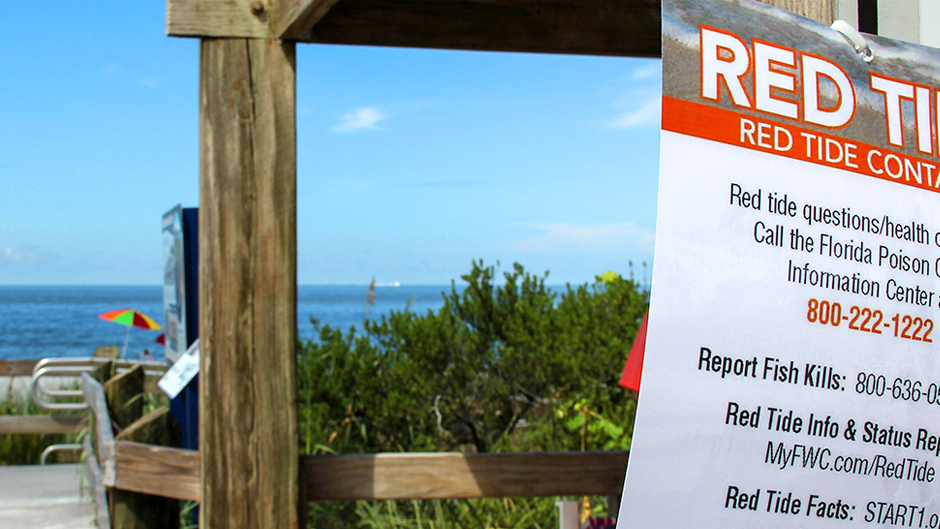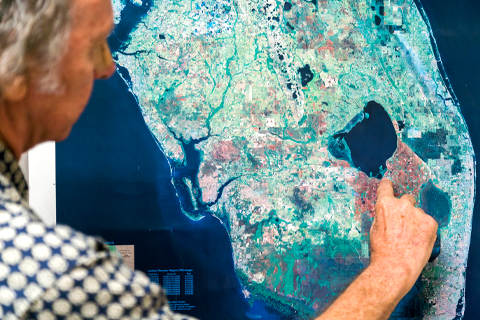Scientists study the impacts of aerosolized algae
UM News, 01-28-2021

Posted along Florida beaches and rivers contaminated by Karenia brevis, the warning signs carry a clear-cut and concise message: No swimming or fishing allowed.
With the blooms growing more frequently and spreading out, the signs have become a common sight during certain times of the year, giving residents and tourists a lesson—albeit a brief one—on the health impacts of being exposed to the marine algae better known as red tide.
“So, as a consequence, many people already have some understanding of how red tide can affect them,” said Grace Zhai, a molecular and cellular pharmacologist at the University of Miami Miller School of Medicine, noting that toxins from the algae can cause skin rashes and irritate the eyes, nose, and throat.
“But what we don’t know a lot about are the immediate and long-term health effects of being exposed to aerosolized cyanotoxins produced by freshwater blue-green algae,” she said. “That’s the big question.”
Now, a new study by Zhai and a team of researchers from the Rosenstiel School of Marine and Atmospheric Science may have provided the answers they need.
Using fruit flies as test subjects, Zhai found that exposing the insects at an early age to aerosolized cyanobacteria, the scientific name for blue-green algae, significantly shortened their lifespan, with reduced survival rates becoming evident as early as 10 days after exposure.
The study highlighted other important findings. It showed that young and late-stage male fruit flies showed marked declines in locomotor function—specifically, their ability to climb—after just 14 days of being exposed to the aerosolized particles., It also indicated that synapse activity in young fruit flies deteriorated significantly after 25 days of being exposed to the particles, indicating the long-term effect of those toxins on the brain and the risk of developing neurodegenerative disease.
“The most vulnerable group proved to be the young fruit flies, 2 to 5 days old,” explained Zhai, whose lab focuses on understanding the genetic and molecular mechanisms of neural degeneration and protection in the context of both common and rare neurodegenerative diseases. “The older flies were more resilient, probably because they had adapted to the environment and had a mechanism of stress response already built in.”
The study, “Exposure to Aerosolized Algal Toxins in South Florida Increases Short- and Long-Term Health Risk in Drosophila Model of Aging,” appears in the December 2020 issue of Toxins.
From phytoplankton ecologist Larry Brand to atmospheric scientist Cassandra Gaston to chemical oceanographer Kim Popendorf, the study was a collaborative effort that involved researchers from multiple disciplines.

Brand collected samples of cyanobacteria-contaminated water from Lake Okeechobee, the Caloosahatchee River, and other lakes and streams along Florida’s west coast. They were brought back to Gaston’s lab at the Rosenstiel School, where researchers generated aerosols from the algae and then exposed the fruit flies to the particles.
“To generate the aerosols, we used a piece of equipment called a bubbler, which produces bubbles by flowing air through a mesh at the bottom of a cylinder filled with liquid—in this case, algae-rich water,” said Haley Royer, a Ph.D. student and atmospheric chemist in Gaston’s lab. “Once the bubbles form, they rise to the top of the cylinder and pop. And that’s what creates the aerosols.”
That method, according to Royer, allowed the team to simulate the process of aerosolization that occurs in the natural environment.
Using a mass spectrometer, Popendorf and her team analyzed some of the aerosols for their toxicity. Blue-green algae produce a multitude of toxins, most notably microcystins, which can damage the liver—as well as BMAA, or β-Methylamino- l-alanine, a non-proteinogenic amino acid that could lead to neurodegenerative diseases like ALS and Alzheimer’s.
“Particle size is particularly important to understand because it can tell us critical information about how harmful the aerosols may be,” Royer said. “Smaller particles, in general, are more hazardous to human health because they can travel deeper into the lungs.”
The fruit fly, or Drosophila melanogaster, was used as a human stand-in for the study because a large percentage of the genes that cause disease in humans are also found in the species. Fruit flies also have short reproductive cycles, allowing researchers to observe several generations of the insect in just a matter of months.
Zhai said the study is unique, demonstrating for the first time the potential health risks of exposure to aerosolized harmful algal blooms. Additional studies on the health impacts of harmful algal blooms are needed, she said.
Brand, who has been sampling for cyanobacteria in Florida waterways for the past 20 years, said the study is also critical because harmful algal bloom outbreaks are becoming more frequent in the state. Nutrient pollution from human activity is cited as one of the causes.
When water levels at Lake Okeechobee, which is rich in agricultural nutrients, rise too high, flood managers, fearing that the dikes will fail, release millions of gallons of water through canals and streams that feed into the Gulf of Mexico and Atlantic Ocean, likely introducing those nutrients to those bodies of water.
A recent localized outbreak of red tide on Florida’s west coast followed a massive discharge of water from Lake Okeechobee, Brand said.
The fruit fly study is part of an ongoing University of Miami Laboratory for INtegrative Knowledge (U-LINK) project aimed at investigating long-term human-health impacts of harmful algal blooms. The project recently received a second year of funding from the Florida Department of Health.